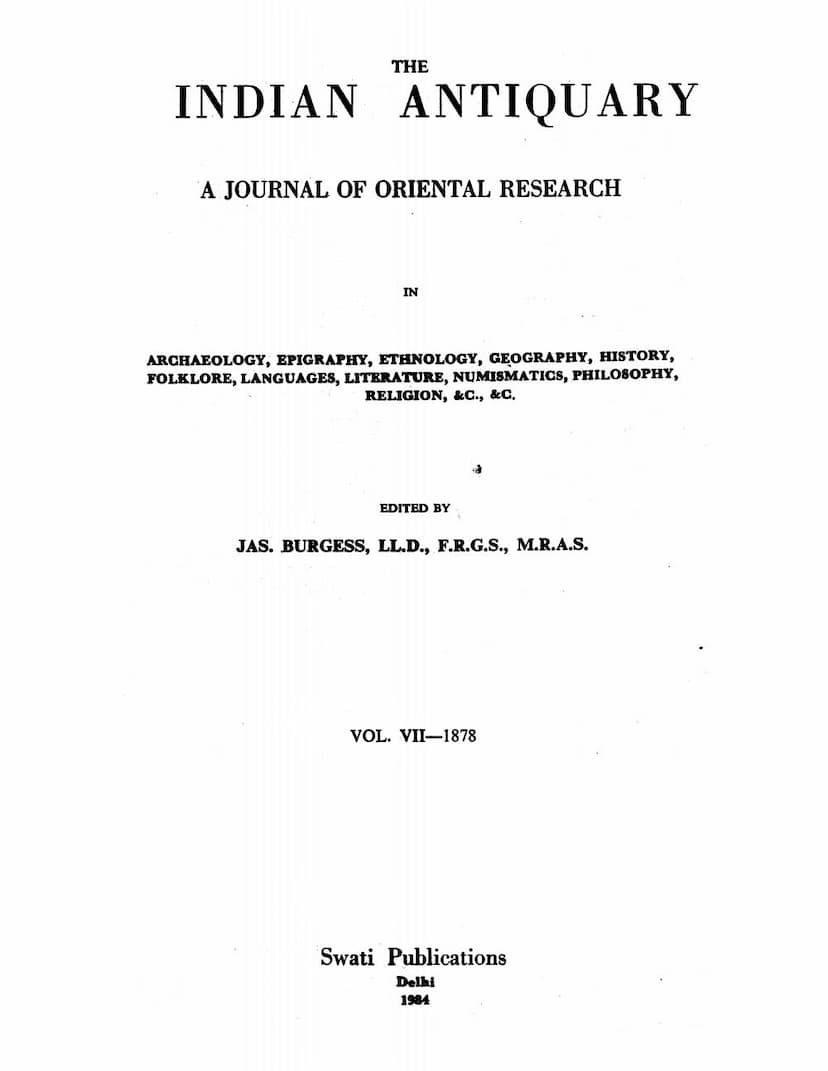Indian Antiquary Vol 07
Added to library: September 1, 2025

Summary
This document is the seventh volume of the Indian Antiquary, a journal of Oriental Research edited by Jas. Burgess and published in 1878. It is a comprehensive collection of scholarly articles on a wide range of topics related to Indian history, archaeology, languages, literature, religion, and philosophy.
Key aspects and themes covered in this volume include:
- Epigraphy and Inscriptions: A significant portion of the volume is dedicated to the transcription, translation, and analysis of ancient inscriptions, particularly copper-plate grants from various dynasties like the Eastern Chalukyas, Western Chalukyas, Kadambas, and Gangas. These inscriptions provide crucial information about royal genealogies, land grants, administrative divisions, and historical events.
- Archaeology and Ancient Sites: Several articles discuss archaeological findings, including:
- Fah Hian's Kingdom of the Dakshina: An exploration of the Chinese pilgrim Fah Hian's account of a significant kingdom in Southern India during the early centuries of the Christian era, with attempts to identify its location and understand its civilization.
- Anandapura in Saurashtra: A historical fragment tracing the origins and legends associated with the ancient city of Anandapura, including its founding and subsequent history through various dynasties.
- Hindu and Jaina Remains in Bijapur: An examination of ancient architectural and sculptural remnants in Bijapur and its surroundings, discussing the styles and influences of different periods, including Chalukya and early Muhammadan adaptations.
- Hypæthral Temple in Orissa: A notice of a remarkable open circular temple in the hill tracts of Orissa, with observations on the identification of ancient sites and the challenges involved in archaeological research.
- Sepulchral Urns and Contracted Burials: Discussions on prehistoric burial customs, comparing findings in Southern India with those in Europe and noting the survival of ancient practices among indigenous tribes.
- The Hissarlik Relics and the Svastika Symbol: An exploration of the origins and meanings of the Svastika symbol, its presence in various ancient cultures including Troy and India, and its distinction from the Greek archaic cross.
- Daggers from the Tanjor Armoury: An analysis of ancient weapons found in the Tanjor armoury, highlighting the prevalence of European blades integrated with Indian craftsmanship.
- Religion and Philosophy: Several articles delve into religious aspects:
- The Digambara Jainas: An account of the Digambara Jaina sect, their beliefs, practices, organization, and literature, with insights into their historical development and differences with the Svetambaras.
- Buddhism in Putu: A brief mention of an island entirely dedicated to Buddhism.
- Hindu Snake-notions: An exploration of various Hindu beliefs, superstitions, and worship practices related to snakes, including their symbolism, mythology, and associated rituals.
- The Wives of Muhammad: A detailed enumeration and biographical sketch of Muhammad's wives, discussing their lineage, marriage circumstances, and historical significance within Islamic tradition.
- Numismatics and Linguistics: While not a primary focus, there are mentions of coins and linguistic analysis, such as in the identification of ancient sites and the discussion of regional dialects.
- Folklore and Traditions: Articles touch upon local legends and traditions, such as the stories surrounding Anandapura, the origins of the Kanphata Yogis, and the customs of fire-walking and snake-worship.
- Historical Narratives: The volume includes accounts of historical figures and events, such as Fah Hian's travels, Hiuen Tsang's observations, the history of the Kanphatas of Kachh, the marriages of Muhammad, the lives of various rulers (Chalukyas, Gangas, Valabhis), and the historical context of the Gorkhas in Nepal.
- Comparative Studies: The journal features comparative analyses, such as the comparison of Hindu and Slavonian folklore regarding meeting eyebrows, the comparison of Trojan and Indian prehistoric pottery, and the discussion of the evolution of language and dialects.
The articles are authored by prominent scholars of the time, including G. Bühler, J. F. Fleet, M. J. Walhouse, Sir Walter Elliot, and others, reflecting a high level of academic rigor and detailed research. The volume is rich in primary source material, particularly inscriptions and historical accounts, making it a valuable resource for understanding the complexities of ancient and medieval Indian history and culture.